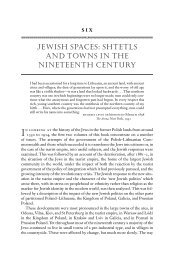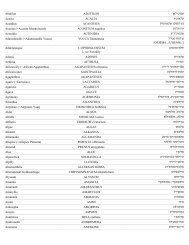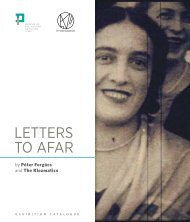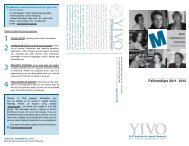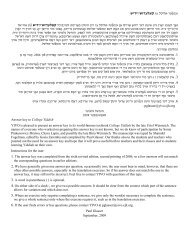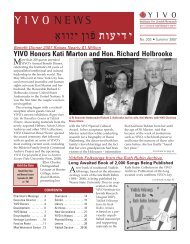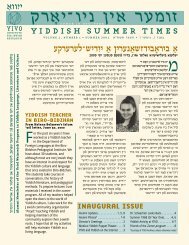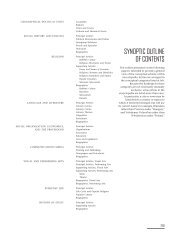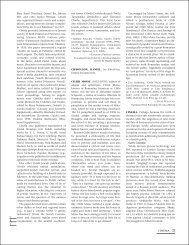Frankism - YIVO Institute for Jewish Research
Frankism - YIVO Institute for Jewish Research
Frankism - YIVO Institute for Jewish Research
Create successful ePaper yourself
Turn your PDF publications into a flip-book with our unique Google optimized e-Paper software.
1. We believe in everything that was taught and commanded by God inthe Old Testament.2. The books of Moses and the other books of the Old Testament can becompared to a richly dressed maiden, whose face is covered and whosebeauty cannot be seen. These books are full of the hidden wisdom ofGod; they speak of things mysterious and of the future, and there<strong>for</strong>ecannot be comprehended by human reason without the assistance ofDivine Grace.3. The rabbis of old times sought to expound the Old Testament. Theirexplanations are known as the Talmud and contain many lies,irrationalities, and much nonsense about and hostility to God and Histeachings.4. On the basis of the Old Testament, we believe that there is one God,without beginning or end, who is the maker of heaven and earth andall things known and unknown.5. We believe that there are three persons within one God, withoutdivision within him.6. We believe that God manifested himself in corporeal <strong>for</strong>m, in allrespects like other human beings, but without sin.7. The city of Jerusalem will not be rebuilt until the end of time.8. Jews have waited in vain <strong>for</strong> the Messiah to come to raise them abovethe whole world.9. On the basis of the Old Testament, we believe that God would himselfbe clothed in human <strong>for</strong>m and would atone <strong>for</strong> all the sins <strong>for</strong> whichthe world was cursed. At his coming the world would be pardoned andcleansed of all iniquity.The disputation took place in Kamieniec Podolski from 20 to 28 June1757. The participants included 19 opponents of the Talmud and 40 rabbis.Frank did not take part in the disputation and it is unclear if he had anyinfluence on the <strong>for</strong>mulation of the theses. Following the disputation,Dembowski issued a verdict in favor of the Frankists. The ecclesiastical courtdismissed evidence supplied by the <strong>Jewish</strong> court of Satanów as slander. Itimposed a number of financial penalties on the rabbis, ordered the flogging ofJews responsible <strong>for</strong> wreaking havoc in Lanckoronie, and condemned theTalmud as worthless and corrupt, ordering copies of it to be burned in thecity square. The court decided that although Judaism offended the Christianfaith and authority, it was <strong>for</strong> the civil authorities to decide if Jews should betolerated in the Commonwealth. At that point it seemed that Sabbatianismwould be legally recognized as a legitimate <strong>for</strong>m of Judaism. Giving up thelong-established tradition that the Christian state would recognize only one<strong>Jewish</strong> religion, the court decided that an individual Jew might change fromone <strong>Jewish</strong> “denomination” to another. Drawing upon the precedent of theKaraites, the verdict of the court defined Sabbatians as Contra-Talmudist
Jews and equated their rights, privileges, and obligations with those of otherJews living in the Commonwealth.Circumstances changed, however, with the sudden death of BishopDembowski on 9 November 1757: the sectarians unexpectedly foundthemselves in a sort of limbo between Judaism and Christianity, lackingsupport and protection from either side. The burning of copies of the Talmudstopped; the campaign against the heretics was renewed with double <strong>for</strong>ce;and many of them fled across the Dniester to Turkey, where they joinedFrank. It seemed that the only viable option <strong>for</strong> the followers of Frank mighthave been to stay in the Ottoman Empire as one of many Sabbatiancommunities, overtly professing Islam while at the same time practicing aheterodox <strong>for</strong>m of Judaism. But the climate in Poland changed again. BishopKajetan Sołtyk, who orchestrated the ritual murder trial of Żytomierz in1753, faced widespread allegations of <strong>for</strong>ging evidence, bribery, and murder.He decided to use the Contra-Talmudists to improve his public image. If Jewsthemselves independently confirmed the accusation of ritual murder, Sołtykwould be able to silence his critics. In order to “prove” that the Żytomierzaccusations were true and that Jews indeed used Christian blood <strong>for</strong> ritualpurposes, Sołtyk in 1758 published the brochure Błędy talmudowe odsamychże Żydów uznane y przez nową sekt ę Siapwscieciuchów, czyliContratalmudystów wyiawione (The Errors of the Talmud Acknowledged bythe Jews Themselves and Revealed by the New Sect of Siapwscieciuchy [i.e.,“Sabbatians”] or the Contra-Talmudists). The pamphlet aimed to confirm thestatements concerning ritual murder using new evidence supplied by theContra-Talmudists. Parallel to the publication of the brochure, Sołtykmanaged to convince King Augustus III to bring the sect back to theCommonwealth. On 11 July 1758, the king issued a letter of safe conduct <strong>for</strong>the Contra-Talmudists who had fled to Turkey. Members of the sect(including Frank) slowly began to return to Poland and establishedthemselves in the estates of Bishop Antoni Sebastian Dembowski, brother ofthe late protector of the Contra-Talmudists Mikołaj Dembowski and a closefriend of Sołtyk.On 20 February 1759, on Sołtyk’s instigation, the Contra-Talmudistsrequested permission <strong>for</strong> another disputation. They called <strong>for</strong> a unity of allfaiths, and promised to prove that Jews used Christian blood <strong>for</strong> ritualpurposes. They presented the following seven points <strong>for</strong> the debate:1. All prophecies about the coming of the Messiah have already beenfulfilled.2. The Messiah is the true God, whose name is Adonai. He took human<strong>for</strong>m and suffered <strong>for</strong> our redemption.3. Since the advent of the true Messiah, sacrifices and ceremonies havebeen abolished.4. Everyone should follow the teaching of the Messiah, <strong>for</strong> salvation liesonly within it.
5. The cross is the sign of the Holy Trinity and the seal of the Messiah.6. A person can achieve faith in the Messiah the King only throughbaptism.7. The Talmud teaches that Jews need Christian blood, and whoeverbelieves in the Talmud is bound to use it.The disputation took place in Lwów from 17 July to 19 September1759. Although Frank did not take part in the disputation, he came to Lwówand was recognized as the leader of the Contra-Talmudists. Pressure fromthe Vatican led to no decisive verdict being promulgated and the rabbis wereobliged only to <strong>for</strong>mulate a written response to the Frankists’ accusations.During the disputation, Frank’s followers became to be treated not as a<strong>Jewish</strong> sect professing tenets that were not recognized by mainstreamJudaism, but as a group of candidates <strong>for</strong> conversion to Christianity. The firstbaptisms took place even be<strong>for</strong>e the <strong>for</strong>mal end of the disputation, and theywere attended by a large public, with many important noblemen acting asgodparents. On 17 September, Frank himself was baptized in LwówCathedral and adopted the name Jakub Josef. Approximately 3,000 peopleconverted in Lwów, Lublin, and Warsaw. Some of them were immediatelyennobled on the basis of a Lithuanian statute of 1588, which gave theprerogatives of the gentry to baptizing Jews and their offspring.The church devoted much ef<strong>for</strong>t to spreading news of the Lwówdisputation. The primate of Poland issued a pastoral letter urging Catholicsto support the converts with alms and ordered that an abridged version of theminutes of the disputation be sent to parish churches and read duringSunday sermons. Reports and manifestos from the disputations weretranslated into Latin, French, Spanish, Armenian, Portuguese, Italian, andGerman and disseminated in different countries. News of the conversionsreached England and the New World.After his baptism, Frank conducted himself ostentatiously. He movedto Warsaw where he was baptized a second time in a royal ceremony, withStarosta Bratkowski acting in the name of King August III as a godfather. Heattended theaters and visited the homes of important magnates. However,several fresh converts in Lwów reported to their confessor that Frank’sadoption of Christianity was not sincere. On 7 January 1760, he wasarrested. Shortly thereafter, the ecclesiastical authorities issued an officialproclamation concerning his case. The proclamation stated that aninvestigation had established the genuineness of belief of the Jews who hadconverted to Catholicism. However, due to the negative influence of theirleader, Jakub Frank, the converts had strayed into erroneous beliefs aboutthe Second Coming and the Last Judgment. As the followers gave excessivehonor to Frank, the authorities decided to separate him from his disciplesand to isolate him at a secluded location, where he was to remain while
awaiting a decision by the Holy See. On 24 February Frank was sent to theCzęstochowa monastery.Relatively little is known about Frank’s thirteen-year stay inCzęstochowa. Sołtyk continued to support his protégé, underwriting Frank’sexpenses in the monastery and allocating special funds <strong>for</strong> settling theconverts in his diocese. Frank was given large and com<strong>for</strong>table quarters <strong>for</strong>himself and his entourage, and was allowed to receive guests and to sendenvoys. His closest disciples gradually began to move to Częstochowa and itssurrounding villages. Although Frank regularly attended Catholic servicesand studied the New Testament, he also conducted his own rituals on thewalls surrounding the shrine. Both the monks and the pilgrims staying in themonastery noted these rituals, but there is no evidence of any ef<strong>for</strong>ts toprevent them from taking place. Frankist sources mention that in 1768 and1769 envoys from Częstochowa went to Podolia, Moldavia, Hungary,Germany, and Moravia. Frank also embarked upon negotiations with theRussians and sent two emissaries to Moscow. In Warsaw, Frankists heldtalks with the Russian resident, Prince Nikolai Vassil’evich Repnin. Inexchange <strong>for</strong> liberation from captivity, Frank promised that 20,000 Jewswould convert to Greek Orthodoxy.Although the Russians decided to turn down his offer, they did setFrank free when Częstochowa <strong>for</strong>tress fell into their hands after the collapseof the Bar Confederation in August 1772. Frank was supplied with passports,left Poland, and headed <strong>for</strong> Brünn (Brno) in Moravia. He was accompanied by18 people, though none of the leaders of the Frankists during thedisputations in Poland belonged to his entourage. The reason <strong>for</strong> his choice ofBrünn (and perhaps even <strong>for</strong> the idea of moving to Moravia) was hisconnection with the Dobruschka family [see Dobruschka-Schönfeld Family].There, he presented himself as a rich merchant <strong>for</strong>ced to leave Poland due tothe adverse effect on trade created by current political disturbances.Although he initially raised some suspicion among the authorities, he wasultimately given permission to settle. In March 1757, he visited Vienna andwas admitted, along with his daughter Ewa, to audiences with Joseph II andMaria Theresa. On numerous occasions he visited Joseph II in militaryencampments. Frank had also dealings with Moravian aristocrats and wasinvolved in various political and spiritual projects. He became a familiarfigure of polite society, and some of his followers and associates made theirway into the enlightened ranks while developing successful careers. Manyalso integrated into surrounding non-<strong>Jewish</strong> communities. The social andregional profile of his following increasingly began to differentiate,occasionally leading to tensions between old members of the sect from Polandand newcomers from Moravia and Germany.As the prospects of an Austro–Turkish war loomed, the idea of utilizingthe Sabbatian network of contacts in the Ottoman Empire was floated.Reportedly, Frank had conversations with Joseph II on arming Jews to fight
Frank as a bankrupt charlatan. Indeed, Ewa Frank incurred numerous debtswith local merchants and was eventually put under house arrest. The courtproceedings against her ended with her death in September 1816.After Frank’s funeral in 1791, the majority of the Polish followers hadleft Offenbach <strong>for</strong> Warsaw. The vacuum left by their departure wasimmediately filled by new arrivals from Prague. During Frank’s lifetime,<strong>Frankism</strong> had spread in Moravia, though there is no evidence of a followingin Bohemia. Nonetheless, the region, and especially Prague, had a strong,independent Sabbatian tradition that predated Frank’s appearance and wasconnected to Yonatan Eybeschütz and his pupils. The Prague Sabbatianswere not very numerous, but with their economic and social standing theyheld an influential position in the <strong>Jewish</strong> community. In the late eighteenthand early nineteenth century, the Prague group was led by the Wehle andHönigsberg families. In contrast to the Polish Frankists, the PragueSabbatians did not engage in open propaganda; <strong>Jewish</strong> authorities initiallytreated the issue as a kind of open secret, preferring to avoid confrontation.After Frank’s death, the Prague Sabbatians established connectionswith the Offenbach court and became Ewa’s main financial supporters, andOffenbach itself was a pilgrimage center <strong>for</strong> the sons of the Prague families.The <strong>Jewish</strong> leaders of Prague decided that the matter could not be ignoredany longer. In autumn 1800, the Sabbatians were excommunicated. In thesame year, Rabbi Eli‘ezer Flekeles delivered a series of sermons against thegroup. Soon after, riots erupted in the city and scores of anti- and pro-Sabbatian pamphlets were printed. Although the Prague group posthumouslyappropriated Frank, there is no evidence of any contact between the PragueSabbatians and the followers of Frank during his life, and it is doubtful thatthis line of development grew organically out of his teachings. [SeeSabbatianism; Wehle Family; and the biography of Flekeles.]Even when Frank was imprisoned in Częstochowa, Warsaw hadbecome the most important Frankist center in Poland. Some of the peoplewho played crucial roles during the disputations moved there, and although afew of them assimilated very quickly and severed their ties to the sect, othersmaintained close ties with Frank and continued to support his court first inBrünn and then in Offenbach. As the Warsaw community grew moreestablished, it gained relative independence from the leadership of the sect inGermany. According to contemporary accounts, the Warsaw Frankists werevery numerous (an anonymous pamphlet printed in 1791 estimated the totalnumber of baptized Frankists living in Warsaw at 6,000 and in the whole ofPoland at 24,000) and were said to monopolize certain trades and professions.This factor led to many conflicts between Polish burghers and the Frankists.In Polish brochures and pamphlets published in Warsaw in the 1790s, theFrankists were portrayed as neither <strong>Jewish</strong> nor Christian, and werecharacterized as managing to escape the control of both <strong>Jewish</strong> and Polishauthorities, operating in a legal vacuum with a peculiar mix of Judaism and
Christianity. Although nominally Roman Catholic, the Frankists reportedlycircumcised their sons, kept the Sabbath, had separate burials, and did notmarry outside their religion. The legal vacuum gave the Frankists an unfairedge in economic competition. Although some of the brochures were openlyantisemitic and attacked “<strong>Jewish</strong>” features of the Frankists, mocking theirdress, awkward Polish pronunciation, and other mannerisms, there seems tohave been a growing feeling that members should be treated as a groupwithin Christianity rather than as an offshoot of Judaism. This perceptionbecame a commonplace in the early nineteenth century and gained officialrecognition in a special ukase on Israelite Christians issued by TsarAlexander I on 25 March 1817.Although there is evidence that the Frankists as a distinct social groupexisted at least until the 1880s, it is very unlikely that Frank’s doctrine wasstill taught in its original <strong>for</strong>m. In nineteenth-century Warsaw, <strong>Frankism</strong>became a kind of a mutual aid association, in which the connections initiallyestablished within the sect were used to facilitate business enterprises. Thegradual evaporation of the religious dimension of the movement made itpossible <strong>for</strong> manuscripts expounding Frank’s teachings to begin to surfaceand become available to scholars.The most important Frankist document, Zbiór słów pańskich (TheCollection of the Words of the Lord) was most likely composed during Frank’sstay in Brünn and then supplemented with additional material during theOffenbach period. The text is in Polish with numerous Hebrew, Yiddish, andLadino interpolations written in transliteration; each Hebrew quotation isaccompanied by a Polish translation. The entire collection had at least 2,194numbered fragments. Prior to World War II, there were at least ninedifferent versions of this manuscript in circulation. The only known Frankistmanuscripts extant today are housed in the Jagiellonian Library in Krakówand in the H. Łopaciński Public Library in Lublin.Zbiór słów pańskich is an assembly of brief stenographic notes thatdocument even the most casual of Frank’s utterances and gestures. Thegreater part of the texts takes the <strong>for</strong>m of a recorded oral transcript, bringingtogether fairy tales, dreams, proverbs, and parables told by Frank to hisfollowers. Although many of the tales paraphrase classical fables from theZohar or midrashic literature, there is a conscious ef<strong>for</strong>t to step beyond atraditional <strong>Jewish</strong> frame of reference. Frankist tales are based on anexegetical principle of tendentious rewriting of traditional <strong>Jewish</strong> narrativesso as to invert established hierarchies, discredit honored symbols, andreevaluate the negative characters of the <strong>Jewish</strong> tradition. Zbiór słówpańskich presents the Revelation on Sinai as a monstrous deception in whichan evil power bestowed nonsensical and harmful laws upon the people ofIsrael. These laws can be countered by what Frank calls the “way to Esau” orthe “way to Life.” The terms denote freedom from constraints andconventions. In some contexts, Life also means physical immortality. The
Way to Life also has a deeply apocalyptic character; it involves not only thedestruction of established institutions but also absolute denial of the world ofcreation, in an attempt to destroy the very structure of the visible universe.BIBLIOGRAPHYMajer Bałaban, Le-Toldot ha-tenu‘ah ha-Frankit (Tel Aviv, 1935); JanDoktór, Śladami mesjasza-apostaty: Żydowskie ruchy mesjańskie w XVII iXVIII wieku a problem konwersji (Wrocław, 1998); Abraham Duker, “Polish<strong>Frankism</strong>’s Duration: From Cabbalistic Judaism to Roman Catholicism andfrom <strong>Jewish</strong>ness to Polishness,” <strong>Jewish</strong> Social Studies 25 (1963): 288–301;Abraham Duker, “<strong>Frankism</strong> as a Movement of Polish-<strong>Jewish</strong> Synthesis,” inTolerance and Movements of Religious Dissent in Eastern Europe, ed. BélaKirály (Boulder, Colo., 1975); Aleksander Kraushar, Jacob Frank: The End tothe Sabbatian Heresy, ed. and trans. Herbert Levy (Lanham, Md., 2001);Harris Lenowitz, “An Introduction to the ‘Sayings’ of Jacob Frank,” inProceedings of the 8th World Congress of <strong>Jewish</strong> Studies (Jerusalem, 1982);Gershom Scholem, “Redemption through Sin,” in The Messianic Idea inJudaism and Other Essays on <strong>Jewish</strong> Spirituality (New York, 1971);Gershom Scholem, “Jacob Frank and the Frankists,” in Kabbalah (New York,1987); Chone Shmeruk, “‘Księga Słów Pana’ Jakuba Franka: Nowespojrzenie,” Teksty Drugie 36 (1995): 107–119.PAWEL MACIEJKOThe article presented above is a sample entry from The <strong>YIVO</strong> Encyclopedia of Jews in EasternEurope, to be published by the Yale University Press. Copyright 2005 <strong>YIVO</strong> <strong>Institute</strong> <strong>for</strong> <strong>Jewish</strong><strong>Research</strong>, Inc. Reproduced by permission of Yale University Press and the <strong>YIVO</strong> Insititute <strong>for</strong> <strong>Jewish</strong><strong>Research</strong>, Inc. All rights reserved.



